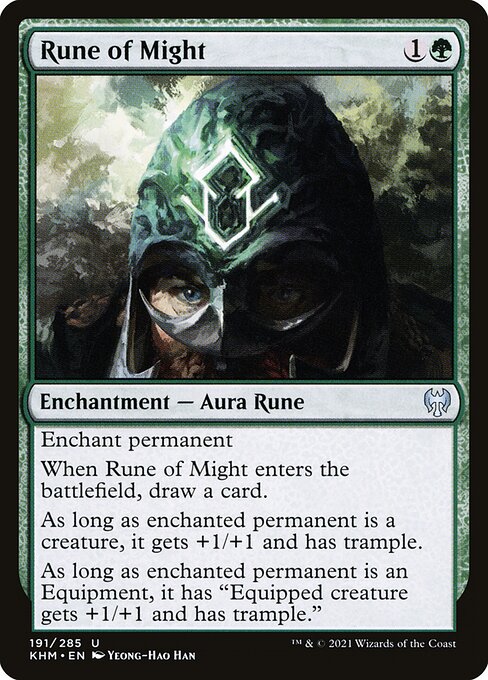
Image courtesy of Scryfall.com
Mana Tricks with Rune of Might
Green mana, a drawn card, and a subtle whisper of “more is better.” Rune of Might is one of those little green enchants that rewards careful tempo and thoughtful timing. For an aura that costs only two mana to cast, it offers a surprisingly flexible payoff: it can lurk on a creature, turning it into a sturdier threat, or hitch a ride on an Equipment to amplify the weapon’s own glory. The result? Mana efficiency that punches above its weight class 🧙♂️🔥. When you play Rune of Might, you’re not just buffing a stat line; you’re weaving card advantage into the turn itself, courtesy of the enter-the-battlefield draw a card clause.
At its core, Rune of Might is a versatile enchantment — a green Aura Rune with a simple, elegant goal: turn your board into something more—without overcommitting mana. The enchant ability is classic MTG: you choose a permanent to attach it to, and you’re off to the races. If the enchanted permanent is a creature, the aura grants +1/+1 and trample. That means a modest critter can become a pounding two-drop that actually pushes through damage, especially in a go-wide or stompy green shell. The trample means any excess power becomes pain for the opponent, which is exactly the kind of disruption green fans adore 💎⚔️.
But Rune of Might doesn’t stop there. If you manage to attach it to an Equipment, the buff shifts slightly but remains devastating: the equipped creature gains +1/+1 and trample via the Equipment’s own aura, effectively turning your late-game weapons into bulldozers. That dual-path design—creature buff or Equipment buff—gives you two reliable levers to pull depending on your deck and matchups. It’s mana-efficient both ways: you pay two mana, you draw a card, and you tilt the board in your favor with a flexible buff that scales with your strategy 🧙♂️🎲.
“In green, tempo is a friend you want riding shotgun.”
Strategically, Rune of Might shines in decks that can capitalize on a steady stream of cards and a scalable threat. If you’re playing a classic ramp-green build, casting Rune on turn two or three can smooth your path to bigger plays while making your early creatures robust enough to weather removal. The On-Enter draw helps you stay ahead on resources, a precious thing when your plan hinges on hitting the right land drops and finding that next payoff spell. Even if your board doesn’t immediately snowball, you’re methodically building inevitability: each time Rune enters, you replace itself with a fresh card, and the buff makes your projection of damage more reliable in the midgame 🧙♂️💥.
In Commander formats, Rune of Might finds a home in green commanders that love to trend toward value rather than pure speed. Its legality across more casual formats and its presence in Historic and Modern ecosystems make it a neat include for green-mavored strategies that lean into equipment or big stompy critters. The card’s uncommon rarity and its availability in foil and nonfoil prints make it a favorite for players who enjoy a little spice in budget-grade or midrange builds. If you’re piloting a creature-heavy plan, the aura’s buff is a meaningful early boost; if you’re piloting an equipment suite, it acts as a parity shift that helps your equipment-based threats finally punch through a tough board state 🔥🎨.
Design-wise, Rune of Might demonstrates how a single enchantment can deliver multiple pathways to victory without overcomplicating the board state. The “Enchant permanent” clause keeps you from overreaching into the wrong type of permanent too early, while the conditional buff ensures the aura remains useful regardless of what you target. Yeong-Hao Han’s art for Kaldheim—layered with runes, forests, and a hint of Norse mythos—plays nicely into the “mana efficiency meets mythic storytelling” vibe, giving players a tangible sense of dipping into ancient magic while pushing modern gameplay forward 🎨⚔️.
If you’re building around Rune of Might, consider pairing it with cheap, evasive creatures or with equipment that rewards the buff with additional effects. A beater with trample becomes a mountain of pain as soon as Rune lands, and if your plan is to draw into your bigger haymakers, the card draw on ETB helps you churn through your deck for the pieces you need. In practice, Rune is best used as a tempo enabler—a two-mana investment that grants card advantage right away and scales up your board presence as the game progresses. It’s the kind of design that makes green feel both comfortable and clever, a reminder that mana efficiency can be beautiful without sacrificing creature-based chaos 🧙♂️💎.
For collectors and players curious about price and rarity, Rune of Might sits at uncommon in the Kaldheim set—an approachable pick for budget builds that still want to show up with teeth. Its foil and nonfoil finishes, and its availability in both paper and digital formats, mean you’re likely to see it in a variety of sleeves and battlestations. And if you’re curious about contemporary MTG culture, you’ll notice how a mana-efficient aura like this often finds a home in discussions about “best tempo plays” and “how to maximize card draw in green” across community blogs and event coverage. It’s a small card with a big smile for players who love to optimize every swing of the mana wheel 🧙♂️🔥.
As you plan your next Friday Night Magic or your next commander showdown, Rune of Might offers a dependable path to turning a two-mana investment into real board advantage. It’s a thoughtful addition to green’s toolbox—one that respects the color’s love of creatures, its occasional forays into equipment synergy, and its knack for making every draw count. So next time you shave one mana off a kill line, remember Rune of Might: the little aura that could, and often does, tilt the entire battlefield in your favor 🧙♂️🎲.
Non-Slip Gaming Mouse Pad 9.5x8.3mm Rubber BackMore from our network
- https://crypto-acolytes.xyz/blog/post/trading-card-games-meet-nft-decks-a-new-frontier/
- https://blog.zero-static.xyz/blog/post/from-ink-to-icon-wilson-urbane-bears-mtg-art-journey/
- https://blog.digital-vault.xyz/blog/post/whats-next-for-digital-entrepreneurship-trends-to-watch/
- https://transparent-paper.shop/blog/post/create-startup-checklist-templates-that-streamline-launch/
- https://crypto-acolytes.xyz/blog/post/day-trading-ai-driven-crypto-tokens-essential-strategies/